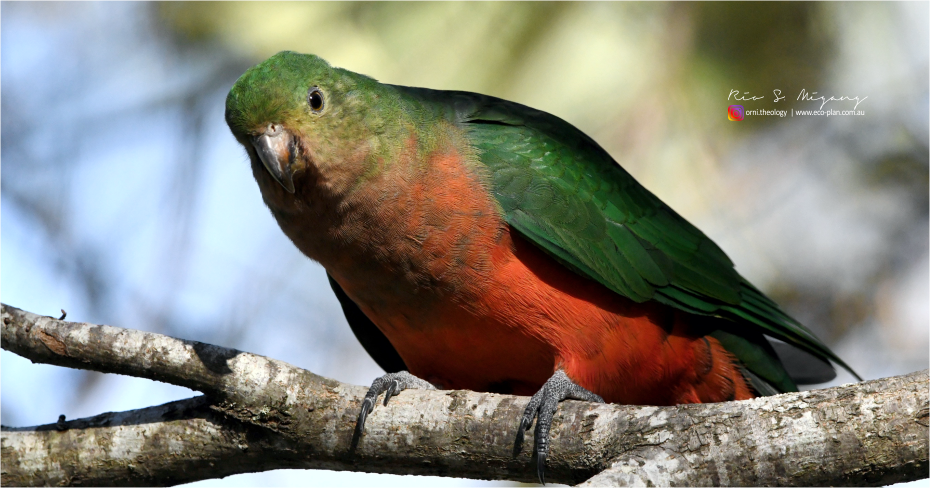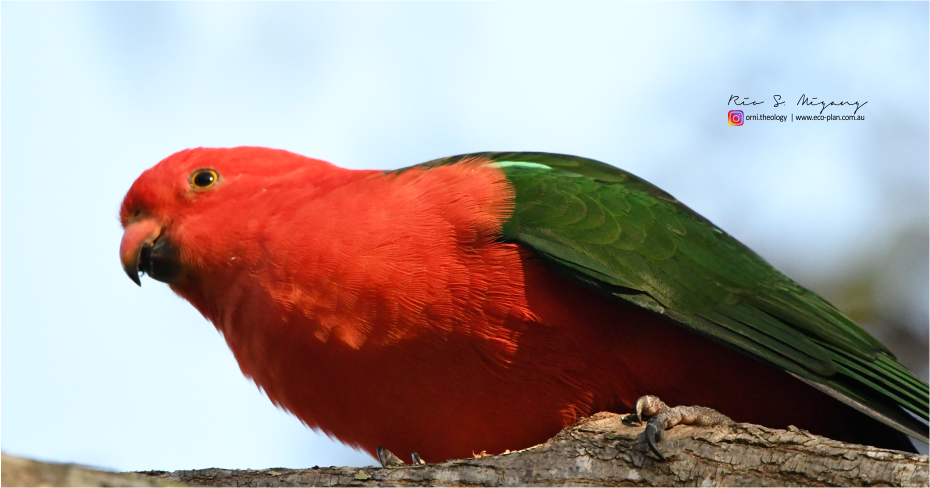This page is dedicated by Rio S. Migang to study, survey and taking picture of wild Australian Birds life around Park & Garden in Melbourne greater area, Victoria state Australia and Macaulay Library (Cornel Lab University, New York www.eBird.org). Feel free to enjoy and share this ornithology page!
Birds as Indicators of Sustainability
Roger Tony Peterson said, 'Birds are indicators of the environment. If they are in trouble, we know we'll soon be in trouble'.
It is expensive and time consuming to accurately assess the biodiversity in an ecosystem. Therefore, scientists often use a representative group to know what is happening in that environment. Several animals or species can act as indicators of environmental health. Birds are one such group that are often used for a number of reasons. Birds are everywhere and they are relatively easily seen and identified and we know a lot about them, their biology and their life-histories. Most people enjoy them for their beauty, their liveliness or their song. Ecosystems are usually so complex that no single component can speak for all the others. Nevertheless, birds can give an indication whether the system is healthy or otherwise, and their study can be a useful way to gain an understanding of ecosystems and their needs. Since a fully diverse ecology is needed to support a healthy number and range of species, a lower than expected number or range of species in an environment clearly indicates a lower ecological diversity. (Birdlife Australia)
Birds as Our Teacher
More than that, John Stott a British theologian expand on Marthin Luther's exhortation from the Sermon on the Mount: "Let the birds be your theologians". It was Jesus Christ himself in the Sermon on the Mount who told us to be birdwatches. Through the birds life, in his book, Stott said man can learn about spiritual realm : true freedom, joy, love, forgiveness, shelter, repentance and faith which is he called it as "orni-theology"or the theology of birds. (Detail about the book please see The Birds Our Teacher: Biblical lessons from a lifelong bird-watcher).
Below some photography documentation about birds of Australia who lives at local parks & gardens:


Rainbow Lorikeet (trihoglossus haematodus) widespread in eastern and northern Australia, and also around Perth. The birds searching out trees in bloom to feast on pollen and nectar. This photo was taken during summer time in December 2017 at Maranoa Garden, Balwyn, Victoria.
**


This remarkable Red Rumpet Parrot (psephotus haematonotusbreeds) lives in small colonies. This photos was taken on Christmas Day 2017 at Studley Park Boathouse, Kew, Victoria.
**


Greylag goose (anser anser) is the largest and bulkiest of the grey geese of the genus Anser. This species is found throughout the Old World. Photos was taken at a pond in Caulfield Park, Glen Eira suburb, Victoria on last week of December 2017.
**


Superb Fairy-wren (Malurus cyaneus) photos taken on 2nd January 2018 at Grampians Mountains, Halls Gap. Adult male Superb Fairy-wrens are among the most brightly coloured and known as Blue Wren. Females and young birds are mostly brown above with a dull red-orange area around the eye and a brown bill.
**


Two different birds photo taken on January 2018 at the top of Pinnacle Lookout, Grampians Mountains. Grey Currawong (Strepera graculina) come with yellow eyes and Australian Raven (Corvus coronoides) with white-blue eyes. More details about them can found here.
**
 Crimson Rosella_web2.png)
 Crimson Rosella_web1.png)
This two sibling (Immature) Crimson Rosella photos taken on January 2018 at Mac Kenzie waterfall. The young Crimson Rosellas have the characteristic blue cheeks, but the remainder of the body plumage is green-olive to yellowish olive (occasionally red in some areas). The young bird gradually attains the adult plumage over a period of 15 months.
**


The mature Crimson Rosella (Platycercus elegans) is relatively easy to see as it forages on the ground or among the leaves of eucalypts, with its spectacular combination of deep-crimson, royal-blue and black plumage. However, not all Crimson Rosellas look the same. Along the Murray River, Crimson Rosellas aren’t crimson at all — they are yellow, black and blue, with the yellow feathering. This photo taken at Ringwood Lake Park & Playground, Victoria on the middle of Spring time, medio November 2018.
**


Long-billed Corella (Cacatua tenuirostris) is a medium-sized white cockatoo. There is a faint yellowish wash on the undersides of its wings and tail, and orange-red splashes on its forehead, throat and an orange-red crescent across its upper breast. This photos taken on January 2018 at Pinnacle Holiday Lodge park, Halls Gap, Victoria.
**


Black-fronted Dotterel is a small wader with a distinctive black face-mask and breast-band and prominent chestnut scapulars (shoulder feathers). The dark eye is ringed with red. In flight the wings look broad and the tail short, while the black and white contrast is striking. Flight is slow with almost hesitant wing beats. This species is also called the Black-fronted Plover.This photos taken on middle of January 2018 at Karkarook Park, Heatherton-Morrabbin, Victoria.
**


Black Swan(Cygnus atratus) are widespread throughout much of Australia, and occur wherever there is a wetland, from river estuaries, bays and great lakes to inundated pasture and water-meadows. The Black Swan is a vegetarian. Food consists of algae and weeds. Black Swans form isolated pairs or small colonies in shallow wetlands. Birds pair for life, with both adults raising one brood per season. This photos taken on January 2018 at Karkarook Park, Heatherton-Morrabbin, Victoria.
**


Galah (Eolophus roseicapillus) can be easily identified by its rose-pink head, neck and underparts, with paler pink crown, and grey back, wings and undertail. Birds from the west of Australia have comparatively paler plumage. Galahs have a bouncing acrobatic flight, but spend much of the day sheltering from heat in the foliage of trees and shrubs. This photos taken on first Ferburayr 2018 at Werribee Park, along the road to Werribee Zoo and Victoria Rose Garden State.
**


Purple Swamphen is a large rail. It is mainly dusky black above, with a broad dark blue collar, and dark blue to purple below. As the Purple Swamphen walks, it flicks its tail up and down, revealing its white undertail. The bill is red and robust, and the legs and feet orange-red. This photos taken on January 2018 at Karkarook Park, Heatherton-Morrabbin, Victoria.
**


Silver Gulls (Larus novaehollandiae) has a white head, tail and underparts, with a light grey back and black-tipped wings. In adult birds (see upper photo) the bill, legs and eye-ring are bright orange-red. Young birds (see second photo) in their first immature plumage that are not yet breeding have a dark eye ring and iris, making their eyes look quite large and uniformly dark. This photos taken on 2nd March 2018 at the lake of Royal Botanic Garden Victoria.
**


Little Black Cormorant is a small, slim, totally black cormorant with a greenish sheen to the back and a slender grey hooked bill. In the breeding season, adults have fine white flecks on the head and neck and the green tinge becomes more bronze. This species congregates in larger flocks than other cormorants and flies in V-shaped formations. This photos taken on last March 2018 at the lake of Boxhill Gardens, Victoria.
**
_web2.png)
_web1.png)
Juvenile Pacific Gull (Larus pacificus) photo was taken during winter time in June 2018 at Batemans Bay, New South Wales. The Pacific Gull is a very large black-backed gull with a massive yellow bill, broadly tipped with scarlet. The upper wings and wingtips are wholly black with a narrow white inner trailing edge, the tail is white with a broad black band near the end. The legs are yellow to orange-yellow. Juvenile Pacific Gulls are mottled dark brown with pale face and the bill is pink with a black tip.
**


New Holland Honeyeater (Phylidonyris novaehollandiae) is a honeyeater species found throughout southern Australia. It was among the first birds to be scientifically described in Australia. The New Holland Honeyeater is one of Australia’s most energetic birds. Fuelled up on high-energy nectar taken from the flowers of banksias, eucalypts, grevilleas and other trees and shrubs, they are always active and pugnacious. This photo taken at Werribee South, Victoria in the end of June 2018.
**


Laughing Kookaburra (Dacelo novaeguineae) is not really laughing when it makes its familiar call. The cackle of the Laughing Kookaburra is actually a territorial call to warn other birds to stay away. Laughing Kookaburras are believed to pair for life. Both sexes share the incubation duties and both care for the young. This photo taken at National Rhododendron Gardens, Olinda, Victoria at the end of October 2018.
*


Australasian Darter (Anhinga novaehollandie), also known as the Snake-bird, has a long and straight spear-shaped bill, elongated neck, and long tail. This species feeds principally on fish. Unlike cormorants, this birds lack a hook at the tip of its bill; it circles high on thermals like a bird of prey, flsapping its large, broad wings. Sociable when breeding, it nests in colonies with other tree-nesting birds. This photo taken at Lilydale Lake Playground, Victoria at Christmas Day, December 2018.
*


Australian King Parrot (Alisterus scapularis) is endemic to eastern Australia ranging from Cooktown in Queensland to Port Campbell in Victoria. Found in humid and heavily forested upland regions of the eastern portion of the continent, including eucalyptus wooded areas in and directly adjacent to subtropical and temperate rainforest. Rio took this juvenile & adult King photos at Maroondah Reservoir Park, April 2018.
*

The Cape Barren goose (Cereopsis novaehollandiae) is a large goose resident in southern Australia. The species is named for Cape Barren Island, where specimens were first sighted by European explorers. It was first described by English ornithologist John Latham in 1801 under the current binomial name. These are bulky geese and their almost uniformly grey plumage, bearing rounded black spots, is unique. This photo taken at Churchill island (Philip island), May 2017.
How to improve your wildlife photography (by Burrard-Lucas)(Improve your wildlife photography.pdf)
Archive of Australian bird photos from early project